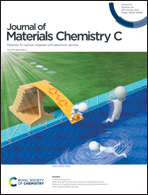In situ coupled electrical/mechanical investigations of graphene coated cationized cotton yarns with enhanced conductivity upon mechanical stretching†
Abstract
In situ coupled mechanical/electrical investigations on graphene coated cationized cotton yarns have been carried out upon cyclic loading, with simultaneous measurements of stress, strain and electrical conductivity. The conductive cotton yarns have been prepared by employing a dip-coating procedure in an aqueous graphene suspension following a cationization process applied to enhance the electrostatic interactions. An increase in the conductivity of the graphene coated yarns by up to four decades is reported upon mechanical stretching, leading to conductivity values as high as 1.1 S cm−1. Furthermore, we demonstrate that this enhancement effect is permanent and leads to reversible conductivity/stress curves after the first mechanical stretching. Our study opens thus new perspectives in the development of textile yarns with enhanced conductivity, with possible applications in the field of smart textile materials.



 Please wait while we load your content...
Please wait while we load your content...